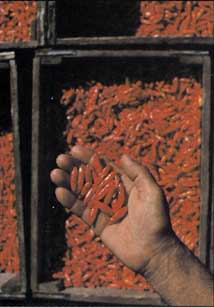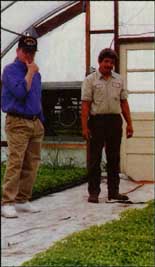|


If their gamble pays off, Lynn Clarkson and Josue Pena might get hot in the pepper market. The two are betting the world's fifth largest Mexican market, which happens to be in Chicago, will warm up to Illinois-grown peppers.
Just outside Cerro Gordo, home to Clarkson Grain, Clarkson and Pena are betting time and money to grow quality peppers closer to market. The sweet bell peppers already are destined for a produce market that currently buys peppers from California. They expect the hot peppersójalapenos, pablanos, serranos and habenerosó to be distributed to Mexican restaurants and groceries.
Clarkson, who is a member of Corn Belt Electric Cooperative, sidesteps a query about the extent of his farming operations. "It's a very competitive world," he quipped. But, he admits to either owning or cash renting more than 2,000 acres producing corn and soybeans. Experimenting is second nature to him, as he tests varieties each year. He already had tested white corn, and found Mexican markets needing it for tortillas. Some of his soybeans go to Japanese specialty markets, for such foods as tofu, soymilk and miso.
It was when Pena, who had experience growing peppers, joined Clarkson as a millwright about two years ago that the two decided to test the pepper market.
"These are being grown on acres I own so I don't have
|
Evaluating alternative enterprises
(You bought the land so now what?)
by Gary Bullen
Farm Business Management and Marketing Educator, Cooperative Extension Service
It is amazing how often people jump into a new enterprise without first taking a good hard look at its feasibility. Without proper planning you will waste precious limited resources. For example, a man came into my office around the first of July asking if I knew of a market for okra. It seems he had read about all the money that could be made from okra. He had estimated that he needed about four acres to support himself. Okra is a very prolific plant. Growing the plant is only half of the equation of a successful enterprise. This man had forgotten to develop his markets before he planted the crop. Steps involved in evaluating a new enterprise include: taking a look at yourself, your family, labor, financial, management and market potential.
Ask yourself "What do I want this to do for me?" Why are you considering this new enterprise? Is one of your goals to supplement your current income? Own your own business? Employment for a spouse? Be specific. How much do you want to make? When do you want to start your business? Will this enterprise meet your family's goals as well as preferences? It is very important to include the whole family in the planning process. The decision to start an alternative enterprise will affect the entire family so sit down with them and discuss everyone's goals and preferences.
|
22 ILLINOIS COUNTRY LIVING SEPTEMBER 1997

to please anybody else," said Clarkson. "If it's a failure, no problem. It's something that's worth doing for the experiment." Buoyed by their first-year success, this year's is their first commercial crop.
This year's spring rains delayed planting until early June and prevented the use of a planter. Each plant in the 10-acre plot was nurtured in a greenhouse and set by hand with the help of Pena's family, which includes his wife, Maria Carmen, praised by Clarkson for her "world-class tamales" and their daughters, Elizabeth and Esmerelda. At harvest, about four extra workers will be needed.
Pepper plants require about 40,000 gallons of water per acre per week to produce, so irrigation is essential. Clarkson and Pena accomplish this by covering the rows with black plastic, and watering the rows through underlying plastic tubes. The plastic holds the weeds out and the moisture in, and will cover the rows until fall when the peppers are harvested.
Cost of production, including irrigation, plastic and labor, runs about $5,500 an acre, compared to corn, which costs about about $190 an acre to produce. At the low end, he expects the peppers will fetch 30 cents a pound; at the high end they might bring as much as 60 cents a pound. If they break even this year, they'll consider it a success. "As long as we break even then I figure we'll get better on a learning curve."
Clarkson said he is unaware of any other pepper growers in Central Illinois, although he knows of one Southern Illinois grower who lost about 70 percent of his crop to disease a few years ago.
He said the University of Illinois horticulture center in St. Charles has provided expertise, but that Pena's knowledge and expertise are key to the project's success. "I could not have done this without Josue," he said.
óby Janeen Keener
|
Is your family willing to make the sacrifices required to make the enterprise successful? Another important question you must ask, "Will I enjoy doing this?"
What are your physical resources, including land, soils, climate, water, buildings, machinery, and equipment?
What about management and labor? These include both on-farm labor and the potential labor supply in the area. Do you have the management skills to produce a nontraditional agriculture enterprise? Just as important as the amount of labor, is time you may have extra labor available. This can be accomplished by developing a monthly labor flow chart. This chart will show you months when you have surplus labor. Match an enterprises' labor requirements to existing labor potential. For example, if you have labor available in early summer months, strawberries may be a good match. Strawberries require 74 hours of labor per acre, of which a quarter comes in May and June during harvest time.
Ralph Watts in his book Vegetable Gardening encourages farmers to study and master marketing as zealously as they learn how to farm. Watts observes in his book that cities don't need more vegetables, they just need better vegetables. Watts' book Vegetable Farming was written in 1911, but remains as valid today as it was almost 90 years ago. Astute marketers will be able to turn trends into profits. Customers today are demanding local, fresh, in-season produce. People are looking for nutrition and health which can be used as a marketing tool. Some people are good at marketing and can create their own markets, while most people must rely on existing markets. Existing markets in the area might include farmers markets, roadside stands, pick-your-own, restaurants, grocery stores, and entertainment farms.
What financial resources do you have available? Starting a new enterprise will require some initial investment, possibly a new building, equipment, or land. What is the maximum amount of cash, savings and credit you are willing to allocate to the new enterprise? Most new enterprises are financed with the families' own money. How will the added cost of the new enterprise affect your cash flow? What's the expected cost and return of the enterprise? Most specialty crops have a higher return but also cost more to grow. Some specialty crops have relatively low yields. Can the enterprise you are considering produce enough volume to make it profitable?
A little thought and time planning the business before you start, can prevent a lot of potential problems as you consider a new enterprise.
|
SEPTEMBER 1997 ILLINOIS COUNTRY LIVING 23
|

